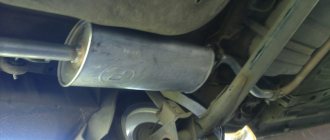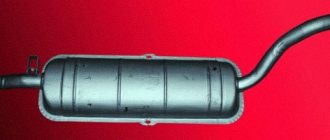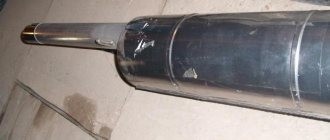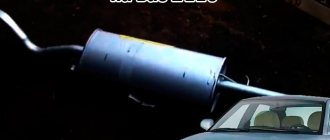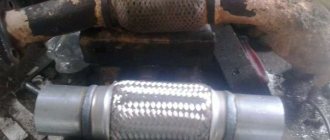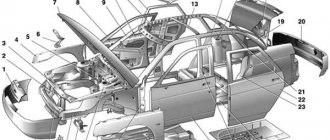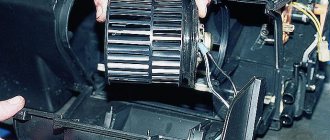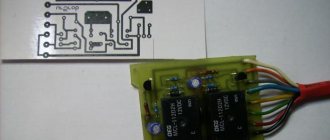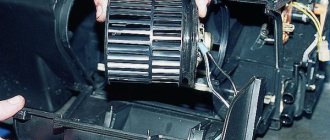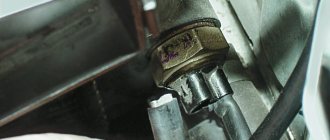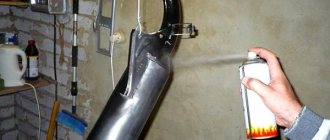Features of operation and types of mufflers
There are two types of mufflers used in modern cars: resonant and direct-flow. Both can be installed in conjunction with a resonator (pre-silencer). In some cases, a straight-through design can replace a front muffler.
Resonator device
Structurally, the muffler resonator, which is also called a flame arrester, is a perforated pipe located in a sealed housing, divided into several chambers. It consists of the following elements:
- body (has a cylindrical shape);
- thermal insulation layer (exhaust gases have a very high temperature);
- blind partition (to turn the flow of gases);
- perforated pipe;
- throttle (allows you to change the cross-section of the exhaust gas flow).
Resonant muffler design
Unlike the preliminary muffler, the main resonant muffler is more complex. It consists of several perforated pipes installed in a common housing, which are separated by partitions and located on different axes (see Fig. Silencer in section):
- front tube with perforation;
- rear tube with perforation;
- inlet pipe;
- anterior partition;
- middle septum;
- posterior septum;
- exhaust pipe;
- body (oval section).
Thus, a resonant muffler uses all types of transformation of sound waves of various frequencies.
Features of a direct-flow muffler
The main disadvantage of a resonant muffler is the effect of creating back pressure, which occurs as a result of redirecting the flow of exhaust gases (when it collides with partitions). In this regard, many motorists tune the exhaust system by installing a direct-flow muffler.
Direct flow muffler
Structurally, the direct-flow muffler consists of the following elements:
- sealed housing;
- exhaust and inlet pipe;
- perforated pipe;
- soundproofing material - fiberglass is most often used, which is resistant to high temperatures and has good sound-absorbing properties.
In practice, a straight-through muffler has the following operating principle: one perforated pipe passes through all chambers. Thus, there is no noise suppression by changing the direction and cross-section of the gas flow, and noise suppression is realized solely through interference and absorption.
Due to the unhindered passage of the exhaust through the direct-flow muffler, the resulting back pressure is very low. However, in practice this does not provide a large increase in power (from 3% to 7%). On the other hand, the car has a characteristic sports car sound, since the noise-absorbing technology present in it only eliminates high frequencies.
The comfort of the driver, passengers and pedestrians depends on how the muffler works. So, during prolonged use, increased noise can cause serious inconvenience. Today, installing a direct-flow muffler in a structure for a car moving within city limits is an administrative violation that threatens with fines and an order to dismantle the device. This is due to exceeding the noise limits specified by the standards.
The operation of the engine in vehicles, if we talk about internal combustion engines, is associated with the production of quite loud noise. But the driver, his passengers, and people on the street practically do not hear this noise effect.
This was not always the case. The first cars running on internal combustion engines were very noisy and created a lot of smoke, and therefore this became a real problem. But after some time they came up with a solution.
Every modern car is necessarily equipped with a muffler. Already from the name it becomes obvious that the main function of mufflers is to dampen and suppress noise and sounds arising from a running engine.
The exhaust system is quite complex, despite the apparent simplicity of its functions. It consists of several elements, one of which is a resonator. Car enthusiasts have questions regarding it. They are interested in what it is, why it is installed and what tasks it performs in the operation of the exhaust system and the entire car.
Types of noise-absorbing elements
Silencers in cars can be active, which is a fairly simple device, or reactive. In the first case, vibration-resistant materials that can withstand high temperatures are used for their production. Active devices are the most popular because they are easy to use. Their significant disadvantage is their rapid contamination. Silencer reactive devices consist of complex elements of resonator chambers.
As for the rear noise-absorbing chamber of the car, its structure contains many compartments that contain a special filler. It is necessary to reduce the sound of exhaust gases when the car engine is running. Modern car mufflers can use several technologies for absorbing background noise and purifying emitted gases at the same time. They can contain many different materials that provide maximum reduction in the sound of exhaust gas flows, their toxicity level and temperature.
Types of car mufflers
Cooling system VAZ 2110 8 valves injector
Modern mufflers are divided into three types: dissipative, reactive and combined.
In turn, the above types are divided into two types: direct-flow and labyrinth.
Dissipative (absorbing).
They belong to the type of direct-flow mufflers and have a simple design.
Consist of:
- Housings;
- Perforated pipe;
- Inlet and outlet pipes;
- Special heat-resistant sound-absorbing filler;
- Steel mesh;
- All this is connected by all-welded joints.
The principle of operation is simple - sound-producing exhaust gases enter a chamber from a perforated pipe where they are absorbed by heat-resistant sound-absorbing material, resulting in the energy of sound vibrations being converted into thermal energy. Mineral wool, metal shavings, and glass wool are often used as such materials.
The advantage of such a muffler is that, depending on the design, it allows you to increase engine power by 5 - 7%, because there is practically no resistance to the exhaust gases escaping.
The disadvantage is increased noise, so such products are primarily tuning and are rarely used on ordinary cars, as a rule, only on sports cars.
Structurally, absorbing silencers can be:
- Strongers or “louvered core glasspack”. They are a pipe with metal petals pressed inside. They are considered ineffective in terms of purging and are rarely used. Mistakenly installed instead of a catalyst.
- With internal diffuser. Not expensive products that have their pros and cons. In terms of noise reduction, they are more effective than other analogues, but in terms of purging, it’s the opposite. The only tangible plus here is the low price.
- With perforated cones of different lengths, treat them as a combined solution. The cones are welded into the main perforated pipe, which significantly reduces noise and at the same time the flow of gases is quite satisfactory for many.
Reactive.
The operating principle of such mufflers is based on the effect of damping reflected waves from each other, which leads to a reduction in noise.
In this design, filling material is not provided; instead, additional pipes, chambers and partitions are welded into the body, chaotically reflecting from which sound waves are damped.
But such mufflers can rarely be found on tuning and sports cars, since their design does not allow achieving good results in terms of aerodynamics, the reason being the high turbulence of the exhaust gases.
Also, in terms of design, reactive analogues are complex and therefore are mainly manufactured in factories.
Diagrams and brief characteristics of reactive mufflers are presented below.
Combined.
This form embodies design solutions from reactive and dissipative mufflers. For example, you can take devices with perforated cones (see above).
They have good efficiency in terms of noise reduction, but in terms of gas flow, the performance is low.
How to reduce exhaust noise
Electrical diagram of VAZ 2110 injector 16 valves
A sound wave can travel in space much faster than gases, therefore, in the design of a muffler, its noise reduction circuit is of great importance. Physical vibrations from sound waves are transmitted to the walls of the exhaust system, and its design is made in such a way that it converts the sound wave into thermal energy, which the exhaust pipe, like a radiator, releases to the atmosphere.
Reducing the noise level of a muffler cannot be achieved without creating some kind of resistance to the exhaust gases, as a result of which part of the engine power, quite insignificant, is spent on overcoming this resistance. To minimize the power loss that noise reduction inevitably leads to, a direct-flow muffler has been developed.
It has a minimum of partitions, does not interfere so much with the passage of exhaust gases and reduce their speed, which is why it sounds completely different.
How to replace a muffler on a VAZ 2110
Valve clearances VAZ 2109 injector 8 valves
We are changing the muffler of the VAZ 2110, the replacement is made in the inspection hole:
- The muffler is connected to the resonator through an o-ring, which is installed in the pipe flare and compressed with a clamp that folds in two halves
- We remove the clamp, then the ring, it is graphite and does not stick to the metal.
Attaching the muffler to the resonator
- Removing the old muffler
- We check the condition of the suspension rubber bands located on the sides of the muffler body. If they have cracks or are stretched, they should be replaced.
VAZ 2110 muffler suspension rubber band
We install a new muffler, first on the rubber bands, then insert a graphite ring (preferably a new one) between the flares and compress it with a clamp.
So we replaced the muffler on the VAZ 2110, replacing the resonator is the next step.
Installation of a new neutralizer
If you decide to modify your car, you can install the Stinger exhaust system on the VAZ-2110. It is more reliable and advanced than stock.
All work is carried out the same way. The neutralizer is installed as follows:
- Install the neutralizer, and then put on the bolts. This must be done very carefully, making half a turn, no more.
- When tightening, you must first tighten the bolts that secure the neutralizer to the resonator. The last to be tightened are the bolts securing the converter to the exhaust pipe.
Typical exhaust system faults
Be sure to verify that there are any problems with the exhaust system before starting any repairs. And identify the node that has become unusable. Any breakdown reveals itself with the following signs:
- Broken connecting pipes. As a result, the integrity of the entire system is compromised and exhaust gases are not properly purified.
- Burnouts on the elements of the main muffler and resonator. This leads to the fact that the exhaust gases are not cleaned, and an extraneous sound appears when the engine is running.
- Strong noises appear from the exhaust system and the main muffler, indicating that there is damage.
If small cracks appear in the VAZ-2110 exhaust system (8-valve injector), then in the early stages they can be healed using sealants. This measure will increase the service life of the elements slightly, by no more than one year.
Burnouts in a small resonator
Diagram of VAZ 21099 injector 8 valves engine diagram
Repairs can be carried out independently. First of all, you need to remove the muffler resonator or other parts of the exhaust system. For simplicity and convenience of operations, such work should be carried out in a pit or on an overpass. This work can be both simple and labor-intensive, since many problems arise due to the fastenings of these parts: they were most susceptible to corrosion and stuck to each other. Experts recommend spraying the fasteners with a special liquid such as WD-40 before starting such work.
In practice, it has been proven that the use of such products gives maximum effect. A large number of these types of sealants and fiberglass fabrics are made from silicone materials; they can withstand high temperatures, some up to 1000 degrees. If you have carried out routine repairs using fiberglass, then it is advisable to start the engine after installing the resonator and warm it up for thirty minutes.
Replacing the muffler on a VAZ 2110
VAZ 2110 owners are quite lucky, since replacing the muffler is quite simple and does not require special skills or extensive experience. But you definitely need an inspection hole.
The replacement procedure sequence is as follows:
- The muffler is connected to the resonator through an O-ring on the pipe flare. Plus, the connection is compressed with a clamp, which consists of two parts.
- The clamp must be dismantled, so remove the ring. Since the O-rings used here are graphite, they should not stick to the metal.
- Now the old muffler can be dismantled quite easily.
- Be sure to check the condition of the suspension rubber bands located on different sides of the muffler body. They often end up stretched or covered with cracks. Rubber bands are quite cheap, so buy new ones and replace the old ones with them.
- The new muffler is first mounted on rubber bands, after which it is inserted into the same new graphite sealing ring between the flares. Use a clamp to compress the connection. Ready!
Impact shield
The fender shield for the exhaust pipe of a power transformer is designed to protect the surface of an adjacent device, which is located at a distance of closer than 30 m, from oil flow: otherwise a fire may occur.
For a single transformer, a shield is not needed; it is enough to simply deflect the exhaust pipe in the required direction. Instead of a fender shield, it is allowed to provide a screen made of fire-retardant material, which is used as basalt wool, compositions based on calcium or aluminum silicates. The height and width of the part must be 300...500 mm larger than the parts of the adjacent unit. The configuration and thickness of the shield are not regulated.
Description of individual components
To make the structure of such an element as the discharge system clearer, it is necessary to give a detailed description of all components:
- Neutralizer. A unit designed for effective purification and suppression of emissions of harmful substances into the environment. When driving, a car produces substances such as non-combustible hydrocarbons, oxide compounds of nitrogen and carbon. The work of this system is aimed at eliminating them. The design itself is a combination of two ceramic-type components. The surface of these components is coated with special afterburning catalysts, which include rhodium, palladium and platinum. These substances make it possible to purify exhaust gases emitted into the environment by almost 100%;
- Lambda probe. It is a special sensor whose task is to control the composition and amount of fuel that enters the engine. The lambda probe thereby controls the purifier. If the lambda probe does not work properly, then the entire output assembly will quickly become unusable, after which it will have to be replaced;
- Reception pipe. Designed for forced removal of exhaust gases from the cylinders of a power unit. The pipe is made of stainless steel, and its fastening to the collector is carried out using special pins, of which there are four in total. The studs guarantee reliable fastening of the two outlet pipes and the element. In order to combine the exhaust pipe and the neutralizer, as well as an additional muffler, hinged fasteners are used;
- An exhaust manifold. A component that is cast from pure cast iron. The manifold is secured with four studs in the exhaust pipe. Heat-resistant gaskets reinforced with metal are installed between the manifold and cylinder heads.
- Silencers. Necessary for effectively suppressing the exhaust rate of burnt gases. This is necessary in order to significantly reduce the noise level in a type of transport such as the VAZ 2110. The distribution device in this part of the unit is carried out as follows: the additional one is followed by the main one. These two components are connected to each other by clamps and sealing rings and are covered with a special casing on top.
How to determine whether a muffler is faulty
All original mechanisms on the VAZ 2110–2112 are adjusted at the factory to ensure a minimum noise level while driving. At the same time, engineers take into account not only the design of the engine itself, but also the car body. Therefore, after tuning the car, the noise level of the muffler increases sharply.
The main malfunctions of the muffler are those factors that interfere with its correct operation:
formation of holes in the body;
The use of such an element is unsafe for the driver
The most common problem with silencers on VAZ 2110–2112 can be considered the occurrence of knocking noises while driving. Even new and original products can cling to the bottom of the car and make loud noises:
Kkiss
https://www.autolada.ru/viewtopic.php?t=142153
Problems with the operation of the device on the VAZ 2110–2112 can be determined visually. To do this, it is recommended to drive the car into a viewing hole or lift the rear of the body on a jack:
Inspect the entire exhaust system pipe. The presence of holes can be noticed immediately. In addition, rust spots will indicate that there is clearly damage inside the muffler housing.
Rock the mechanism with your hand - if it sways too much, then it’s time to change the fixation rubber bands and the reinforced gasket between the parts of the muffler.
After leaving the inspection hole, start the engine and sharply press the gas pedal several times - black exhaust smoke indicates severe burnout of the product.
Why do you need a gasket?
The gasket is an essential element between the main muffler and the resonator. Since all parts of the exhaust system become very hot, the gasket is made of heat-resistant materials.
If, when replacing a resonator or muffler, a gasket is not inserted between them, then the joint will not be as tight as possible. In addition, when driving on uneven roads, the two elements will rub against each other and quickly fail.
There is no need to worry about the procedure for replacing the gasket: it has a convenient shape and is placed on the element pipe with one movement of the hand:
- Attach the gasket to the resonator flange.
- Tighten 4 bolts.
- Make sure the insert is kept level.
- Tighten the bolts until they stop, without overtightening them.
The product prevents heating of muffler parts
Replacing rubber bands
The VAZ 2110–2112 muffler is attached to the bottom of the car with special rubber hangers. The elastic bands have minimal elasticity, so they can ensure reliable fixation of the mechanism. Usually two rubber bands are used - one is placed at the exhaust port, the other at the compartment with the resonator.
To change the suspension rubber bands, you need to place some kind of support (boards or bricks) under the device to fix its position at the maximum height. After this, the old rubber bands are removed. If necessary, the hooks on the bottom, on which new rubber bands are put on, can be cleaned of dirt and carbon deposits. After which the muffler is easily attached with hooks to the new rubber hangers. The suspensions are removed one by one from the front of the car to the rear.
The special rubber composition allows you to keep the muffler in the desired position for many years
What to do if the muffler is knocking
Knocking is one of the most common problems with silencers on the VAZ of the tenth family. Mufflers can knock only in two cases: when, while driving, they touch the body of the gas tank or swing so that they hit the body.
The knocking can be eliminated by simply replacing the rubber suspensions: during operation they can stretch, so the muffler no longer has a reliable fixation to the bottom. In addition, the “silencer” can often knock because it was installed incorrectly during installation: for example, the flange is not fully tightened or the bolts do not match the length of the bracket. Therefore, the replacement procedure must take into account all the nuances of the correct installation of exhaust system elements.
basic information
The muffler of a VAZ car always receives increased attention, because its main task is to reduce the noise level, which is important. First, let's look at how the pre-muffler, or as it is also called the resonator, of a VAZ car works. A resonator is considered to be a medium type of muffler, which is located in the middle of the exhaust system. So, the pre-muffler consists of the following main elements:
- Throttle;
- Frame;
- Blind barrier;
- Thermal insulation;
- Perforated tube.
Now let's look at the design of this part of the transport:
- Frame;
- Rear barrier;
- Middle obstacle;
- Front perforated tube;
- Rear perforated tube;
- Inlet pipe;
- Exhaust pipe.
VAZ muffler design
What are the design features of a direct-flow muffler? The main element of this type of muffler is a perforated tube. With the help of perforation, the combustion products that enter the muffler expand quite effectively in its body. Thanks to these actions, the removal of combustion products is accelerated. It is worth paying attention to the fact that high-quality tuning can account for more than eighty percent of a straight tube. This means that when using the presented type of muffler, the level of exhaust system resistance will be about ten percent, and this is much more than without it.
Independent replacement of the main and additional muffler
The exhaust system of every vehicle regularly suffers from the accumulation of dirt, dust, moisture, corrosive and hot gases, as well as impacts. Moreover, applying patches to through holes will help solve the problem only for a certain period of time, and in the end, one way or another, a complete replacement will have to be made.
The exhaust system of a VAZ car can be subject to such main factors of destruction as:
- Heating the structure to high temperatures;
- Internal corrosion;
- External corrosion;
- Beats;
- Various damages and deformations;
- Constant vibration;
- Frequent changes in temperature conditions, from the heating process to rapid cooling;
- There are no effective means of protecting metal structural elements;
- Pollution;
- The influence of abrasive particles falling from the roadway;
The most vulnerable point of the exhaust system, which requires regular monitoring, is the muffler. Let's try to figure out how to replace the main muffler. The main signs that indicate the need to replace the housing of this device:
- Areas of through corrosion;
- Pipe fractures;
- Fractures of the hull;
- Deformation.
The main muffler is attached to the bottom of the vehicle using brackets and hanging rubber bands, and it is attached to the resonator pipe by fastening two parts of the clamps with bolts that tighten the flared ends.
So, the replacement algorithm:
- Unscrew the bolts that hold the clamp halves together;
- Remove the graphite O-rings;
- Remove the part from the hanging rubber bands. If such a need arises, you need to replace the hanging rubber bands.
- Hang a new one;
- Install a graphite seal at the junction of the pipes;
- Put on the clamp;
- Tighten the clamp halves using bolts.
Now we move on to considering the replacement of the additional muffler. Additional mufflers are not attached to the underbody of the vehicle. They are connected to the inlet pipes using clamps.
So, the replacement algorithm:
- Remove the main muffler;
- Loosen the clamp nut slightly;
- Using a screwdriver, spread the clamp and move it along the tube;
- Unscrew and remove them from the drain manifold tube.
The car should not only drive well, but also sound great. A good car is beautiful in all respects, and its beauty partly depends on the sounds that the equipment makes. The spectacular sound of a closed door, with a noble low overtone, the muffled clicking of the turn relay, the dense rustle of the headwind at a speed of 180 km/h. And, of course, the exhaust sound. It is the muffler that forms the first impression of the car and we will talk about the muffler today.
Car muffler diagrams
A cross-section of a car muffler allows you to see exactly how the sound reduction function is implemented in each specific muffler. In direct-flow mufflers, for example, the method of changing the direction of gas movement is never used, and a standard muffler uses turns from 90 to 360 degrees. The change in the amplitude of sound wave oscillations is realized by perforating the internal pipes. It is these internal pipes, their diameter, diameter and frequency of holes that can drown out noise in almost the entire frequency spectrum.
But only the integrated use of these methods can guarantee high efficiency of the entire exhaust system as a whole. Therefore, modern cars use from one to six different mufflers. The main ones are the resonator and the main muffler.
Malfunctions on VAZ cars of the tenth family
AvtoVAZ specialists conducted research, the results of which revealed that the car body, being a closed structure, has its own peak harmonics and can resonate at a certain frequency. To suppress spurious frequencies emitted by both the vehicle engine and those shielded by the body, it is necessary to use the range from 60 to 400 Hz, corresponding to medium and high engine speeds. A change in noise characteristics can be caused by making minimal changes to its design.
The most difficult noise to deal with is at low frequencies. From a technical point of view, it is impossible to combine tuning the exhaust system of a car and combating noise. You can maintain maximum power with a direct-flow muffler, and reduce the sound to a comfortable volume with a factory one.
Owners of VAZ 2110–2112 most often encounter breakdowns, burnouts and leaks in the exhaust system. Incorrectly set ignition, excessively rich mixture and pipe corrosion are the main causes of burnt out exhaust pipes. This defect is accompanied by knocks and pops, which indicate burnout of metal parts. A sign of burnout may be smoke from the exhaust pipe, indicating an overly enriched fuel mixture that is burning in the exhaust pipe.
Car muffler malfunctions can be caused by various reasons - pipe burnout, system leakage, breakdowns
The appearance of knocks on the body in the area where the muffler is located indicates mechanical defects in the part - changes in geometry, destruction of the rubber band, suspension or damper cushion. Eliminated by identifying the location of the breakdown and troubleshooting. Worn parts are replaced with new ones.
Muffler gaskets
The gas junction formed between the rear and additional mufflers is insulated using a rubber gasket or O-ring. In addition to the main function of closing the gap, it is also used to eliminate the movement of the pipes of the part relative to each other.
Rubber O-ring located between the car muffler flanges
The appearance of carbon deposits under the bottom of the car at the joints of the exhaust pipe sections indicates damage to the gasket. Ruptures of the sealing ring are accompanied by the appearance of an unpleasant smell of exhaust gases in the vehicle interior and a sharp grinding noise that occurs during operation of the power unit.
Their replacement
A damaged exhaust system sealing ring cannot be restored - it can only be replaced with a new one. The gasket can be replaced manually in a few minutes.
- The exhaust pipe flanges are secured with small bolts. Due to prolonged use, they can become covered with dirt and rust, which makes them difficult to unscrew. You can unscrew the bolts using a special tool or a grinder.
- After unscrewing the bolts, the resonator tube is carefully retracted to the left.
- The old O-ring is located on the resonator pipe. The rubber product is easily pryed off with a flat screwdriver and removed.
- Carbon deposits are removed from the flanges with a wire brush and sandpaper.
- A new O-ring is installed on the resonator tube flange. The exhaust pipe flanges are connected with a clamp, and the main muffler pipes are also connected to each other.
Installing a new exhaust pipe
All work is done in reverse order. But there are several features that you definitely need to know:
- Install a new exhaust pipe.
- A new gasket needs to be installed between the exhaust manifold and the pants.
- Be sure to install a new O-ring between the neutralizer and the pants.
- Tighten the nuts on the exhaust manifold studs. Tighten them evenly in a crisscross pattern.
- Tighten the bolts that are on the spring-loaded connection to the converter.
This completes the repair of the exhaust system. The sound will be muffled as much as possible, the car will become almost silent. It is advisable to lubricate the new gasket with a CV joint type compound. This will improve the seal.
The operation of VAZ cars is often accompanied by various breakdowns and malfunctions of various parts and systems. The 2110 exhaust system is no exception, failures of which can be eliminated by replacing the muffler or other components.
Composition of the output unit
The exhaust system for a VAZ 2110 car consists of the following elements:
- Exhaust manifold;
- Lambda probe;
- Receiving type pipes;
- Neutralizer;
- Two mufflers: main type and additional.
Not all exhaust components are disassembled; some parts, such as the converter, as well as both mufflers, are replaced entirely.
Exhaust system of VAZ 2110
Description of individual components
To make the structure of such an element as the discharge system clearer, it is necessary to give a detailed description of all components:
- Neutralizer. A unit designed for effective purification and suppression of emissions of harmful substances into the environment. When driving, a car produces substances such as non-combustible hydrocarbons, oxide compounds of nitrogen and carbon. The work of this system is aimed at eliminating them. The design itself is a combination of two ceramic-type components. The surface of these components is coated with special afterburning catalysts, which include rhodium, palladium and platinum. These substances make it possible to purify exhaust gases emitted into the environment by almost 100%;
- Lambda probe. It is a special sensor whose task is to control the composition and amount of fuel that enters the engine. The lambda probe thereby controls the purifier. If the lambda probe does not work properly, then the entire output assembly will quickly become unusable, after which it will have to be replaced;
- Reception pipe. Designed for forced removal of exhaust gases from the cylinders of a power unit. The pipe is made of stainless steel, and its fastening to the collector is carried out using special pins, of which there are four in total. The studs guarantee reliable fastening of the two outlet pipes and the element. In order to combine the exhaust pipe and the neutralizer, as well as an additional muffler, hinged fasteners are used;
- An exhaust manifold. A component that is cast from pure cast iron. The manifold is secured with four studs in the exhaust pipe. Heat-resistant gaskets reinforced with metal are installed between the manifold and cylinder heads.
- Silencers. Necessary for effectively suppressing the exhaust rate of burnt gases. This is necessary in order to significantly reduce the noise level in a type of transport such as the VAZ 2110. The distribution device in this part of the unit is carried out as follows: the additional one is followed by the main one. These two components are connected to each other by clamps and sealing rings and are covered with a special casing on top.
Nuances of operation
There are some points that need to be taken into account when operating the VAZ 2110 system:
- Under no circumstances should the vehicle be refueled with leaded fuel, as this will cause damage. It is very sensitive to lead compounds;
- When operating a VAZ 2110 car, you also need to monitor the proper, precise operation of the ignition, since its poor-quality operation leads to the neutralizing part being removed from its working condition. Fuel that does not burn when a spark passes during ignition enters the converter and burns out there. For this reason, the ceramic coating of the component quickly deteriorates;
- Frequent malfunctions will sooner or later lead to complete or partial blockage of the output system, in turn to the failure of the engine and its repair or replacement will be required.
Troubleshooting
The operation of a machine is always associated with the occurrence of malfunctions in parts and mechanisms. If some parts become unusable, then they need to be replaced or repaired yourself.
To replace the additional muffler in the exhaust unit:
- unscrew the two bolts that secure the clamp, for this you need a 13mm wrench;
- remove the clamp itself;
- remove the ring;
- disconnect the additional suspension cushions;
- remove the unit.
After this, a replacement is made, it is mounted in place in the reverse order. These are basic troubleshooting repair steps.
In addition to replacing standard faulty components with the same ones, but only new ones, you can modify individual components of the exhaust system, or tune the entire assembly.
Source
